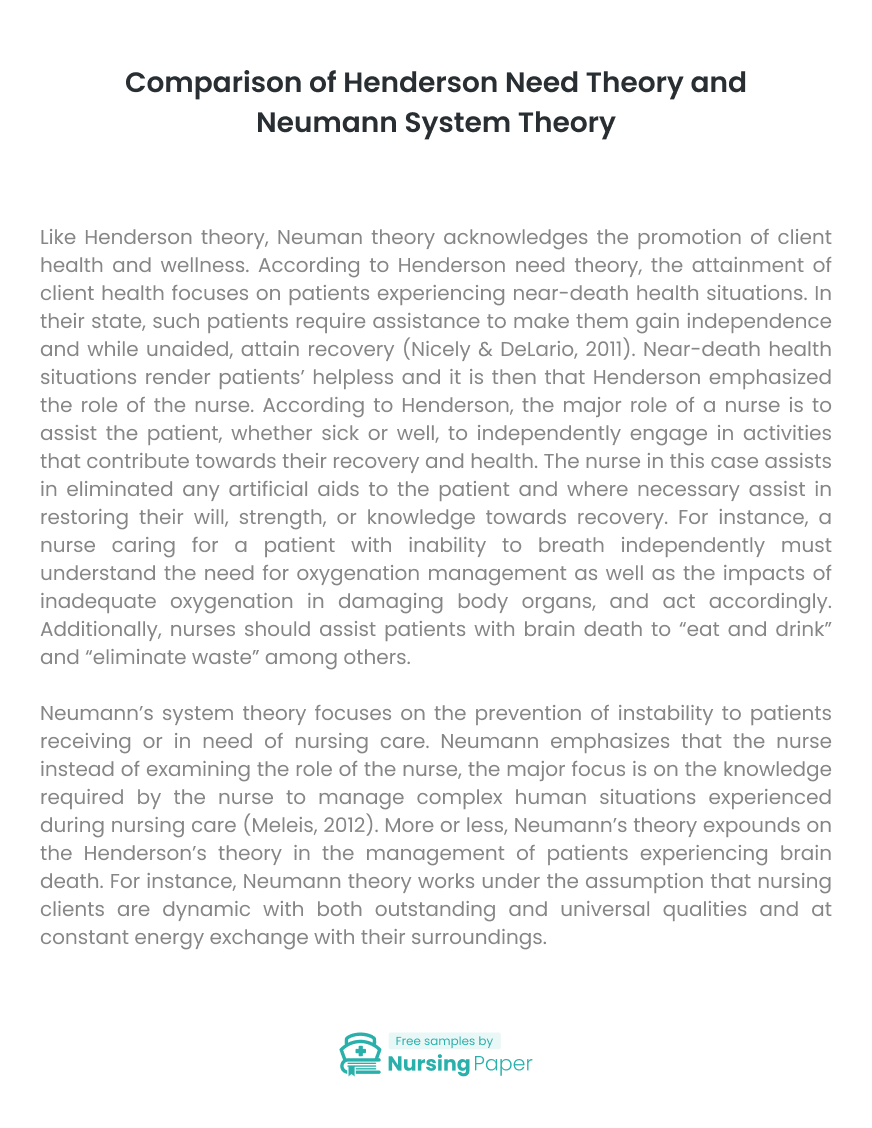
Comparison of Henderson Need Theory and Neumann System Theory
Introduction
Like Henderson theory, Neuman theory acknowledges the promotion of client health and wellness. According to Henderson need theory, the attainment of client health focuses on patients experiencing near-death health situations. In their state, such patients require assistance to make them gain independence and while unaided, attain recovery (Nicely & DeLario, 2011). Near-death health situations render patients’ helpless and it is then that Henderson emphasized the role of the nurse. According to Henderson, the major role of a nurse is to assist the patient, whether sick or well, to independently engage in activities that contribute towards their recovery and health. The nurse in this case assists in eliminated any artificial aids to the patient and where necessary assist in restoring their will, strength, or knowledge towards recovery. For instance, a nurse caring for a patient with inability to breath independently must understand the need for oxygenation management as well as the impacts of inadequate oxygenation in damaging body organs, and act accordingly. Additionally, nurses should assist patients with brain death to “eat and drink” and “eliminate waste” among others.
Neumann’s system theory focuses on the prevention of instability to patients receiving or in need of nursing care. Neumann emphasizes that the nurse instead of examining the role of the nurse, the major focus is on the knowledge required by the nurse to manage complex human situations experienced during nursing care (Meleis, 2012). More or less, Neumann’s theory expounds on the Henderson’s theory in the management of patients experiencing brain death. For instance, Neumann theory works under the assumption that nursing clients are dynamic with both outstanding and universal qualities and at constant energy exchange with their surroundings. This knowledge assists nurses caring for brain death patients to persistently provide the necessary assistance to promote patient wellness and health. Additionally, Neumann’s theory’s assumption of nurses actions being directed towards primary, secondary, and tertiary prevention would act as a guide to nurses caring for near death patients. The combination of Henderson and Neuman’s theories contribute towards the nursing goal of keeping the client’s system stable despite the threats subjected to them by different stressors, and with the assistance of nurses (Fawcett & Desanto-Madeya, 2013).


1. Fawcett, J., & Desanto-Madeya, S. (2013). Contemporary nursing knowledge : analysis and evaluation of nursing models and theories (3rd ed.). Philadelphia: Davis Company.
2. Meleis, A. (2012). Theoretical nursing : development and progress (5th ed.). Philadelphia : Wolters Kluwer Health/Lippincott Williams & Wilkins.
3. Nicely, B., & DeLario, G. (2011). Virginia Henderson’s principles and practice of nursing applied to organ donation after Brain Death. Progress in Transplantation, 21(1), 72-77.



The download will start shortly.

The download will start shortly.
 Subject:
Nursing
Subject:
Nursing  Number of pages: 3
Number of pages: 3  Subject:
Nursing
Subject:
Nursing  Number of pages: 4
Number of pages: 4  Subject:
Nursing
Subject:
Nursing  Number of pages: 3
Number of pages: 3  Subject:
Health and Social Care
Subject:
Health and Social Care  Number of pages: 2
Number of pages: 2  Subject:
Nursing
Subject:
Nursing  Number of pages: 4
Number of pages: 4  Subject:
Medicine
Subject:
Medicine  Number of pages: 2
Number of pages: 2  Subject:
Medicine
Subject:
Medicine  Number of pages: 3
Number of pages: 3  Subject:
Medicine
Subject:
Medicine  Number of pages: 2
Number of pages: 2  Subject:
Nursing
Subject:
Nursing  Number of pages: 5
Number of pages: 5  Subject:
Nursing
Subject:
Nursing  Number of pages: 2
Number of pages: 2  Subject:
Medicine
Subject:
Medicine  Number of pages: 4
Number of pages: 4  Subject:
Medicine
Subject:
Medicine  Number of pages: 7
Number of pages: 7  Subject:
Medicine
Subject:
Medicine  Number of pages: 6
Number of pages: 6  Subject:
Health and Social Care
Subject:
Health and Social Care  Number of pages: 2
Number of pages: 2  Subject:
Health and Social Care
Subject:
Health and Social Care  Number of pages: 2
Number of pages: 2 
